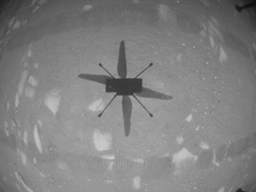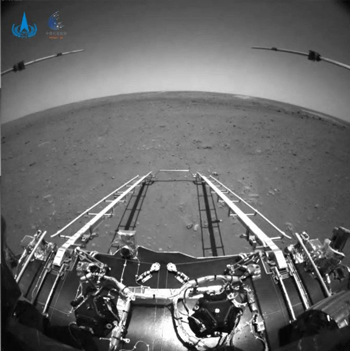
June 2021 - Vol. 25, No. 6
This Month's Night Sky - NOTE: The next paragraph describes the sky as it appears at 10 pm EST (11 pm EDT) near mid- month. The sky also looks this way at 11 pm EST (midnight EDT) during the beginning of the month and at 9 pm EST (10 pm EDT) by month's end.
Spica (Virgo) glows in the SW while Regulus (Leo) vanishes over the W horizon before midnight. The "big dipper" (Ursa Major's asterism) now stands on its "handle" in the N. Antares (Scorpius) is low on the S horizon. The Eastern sky is dominated by the "summer triangle" asterism: Deneb (Cygnus), Vega (Lyra) and Altair (Aquila). An interesting star tour begins at the last star of the big dipper's handle, Alkaid. Following the curve of the handle, "arc to Arcturus". Now, following the same curve, "spike to Spica" and "continue to Corvus", its distinctive four star, kite-shaped, asterism.
MERCURY reaches inferior conjunction on the 11th, emerges in the evening sky favoring southern observers by the end of the month. VENUS reaches its most northerly declination this year, although it will not be high in the evening sky as it moves from Gemini to Cancer this month. MARS in the evening sky also moves from Gemini into Cancer this month, shining at 1.8 mag will be very hard to spot. JUPITER rises after midnight, reaching its stationary point in Aquarius this month. SATURN rises just before midnight at the beginning of the month, moving in retrograde motion. URANUS is in the morning sky still close to the rising Sun. NEPTUNE rises after midnight among the stars of Aquarius.
Review how to determine Angular Measurement.
Calendar of Events
NOTE: For those observers not in the ET zone, convert the calendar times to your zone's time by subtracting one hour for CT, two for MT and three for PT. Don't forget to adjust for Daylight Savings Time when necessary by subtracting one hour from your planisphere's time. Dawn and dusk times must also be corrected. See your local newspaper, TV news, or cable TV's Weather Channel for sunrise and sunset times or check with the U.S. Naval observatory. Unfortunately some of these events may occur during daylight hours in your area.
| DATE | EVENT |
| 01 | Jupiter 5 deg. N. of Moon. |
| 04 | Mars at greatest heliocentric lat. N. |
| 06 | Juno at opposition. |
| 07 | Uranus 2 deg. N, of Moon |
| 08 | Moon at apogee. |
| 10 |
Annular Solar eclipse. Mercury at aphelion. |
| 11 | Mercury inferior conjunction. |
| 12 | Venus at perihelion. Venus 1.5 deg. S. of Moon. |
| 13 | Mars 3 deg S. of Moon. |
| 21 |
Solstice Jupiter stationary. |
| 22 | Mercury stationary. |
| 23 |
Moon at perigee, expect large tides. Mars in Beehive (M-44) |
| 26 | Neptune stationary. |
| 27 | Saturn 4 deg. N. of Moon. |
| 28 | Jupiter 4 deg. N. of Moon. |
| 30 | Mercury at greatest heliocentric lat. S. |
Lunar Almanac for June 2021
| Phases of the Moon | Phase and Date(s) | Best viewed before local midnight |
 |
New 10 |
Deep Space Objects |
 |
1st. Qtr 17 |
Planets & Moon |
 |
Full 24 |
Moon |
 |
Last Qtr 02 |
Deep Space & Planets |
Topic of the month: Mars 2021 Explorers
NASA Mars2020 Mission update
NASA's Mars 2020 mission continues on the surface of Mars. As of June 1, the Rover has been on the surface for 100 Sols or martian days. Mars Perseverance was NASA's 5th rover to land successfully on Mars. Meanwhile, Mars Rover Curiosity has been exploring the Gale crater for 3135 sols. It has driven over 15 miles (~24 km) and sent back over 800,000 images of Mars.

The Mars 2020 rover, Perseverance, also called Persy, has traveled 350 meters on Mars. It is being prepared to take its first core sample. The sample will be picked up by a later mission to the red planet. Persy also carried a small helicopter in its belly. This helicopter is named, Ingenuity and has proved for the first time that flight is possible on another planet in the solar system, specifically, Mars! The helicopter carries with it a piece of the original Wright Brothers Flyer. Ingenuity's launch and landing site has been named, Wright Brother's Field by the Mars Helicopter Team.
Here is a close up selfie that Persy took with Ingenuity on April 6, 2021. NASA released this image and all of the others that are here in this article. Some of them have been modified (i.e. cropped and shrunk) to fit the web pages here at Astra's. There are many images available from NASA with more appearing regularly. NASA's original image of Perseverance’s selfie with Ingenuity is made up of 62 individual images stitched together once they are sent back to Earth. This image is taken with Perseverance's WATSON (Wide Angle Topographic Sensor for Operations and eNgineering) camera at the end of the rover's robotic arm.
Ingenuity's purpose is to test powered flight in Mars' thin atmosphere, operate autonomously, and test miniaturized flying technology (i.e., computers and electronics). In April 2021, Ingenuity proved itself by making 4 powered flights that month. The first flight came on April 19, 2021. The helicopter rose 10 feet or 3 meters, it hovered, rotated and landed successfully. The whole flight sequence took only 39 seconds, but Ingenuity proved itself expertly. Ingenuity took a picture of its own shadow while it was performing its first flight. Ingenuity's second flight occurred on April 22 , 2021. It rose up 16 feet (4.9 m)in a vertical takeoff and then stopped. It flew .5 meters per second during this flight that lasted 51.9 seconds. Ingenuity proved that the atmosphere on Mars could be used to lift and navigate the small helicopter. It returned the first color image of the Martian surface taken by an aerial vehicle while it was aloft. On April 25, 2021 the third flight lasted 80-seconds. It rose 17 feet (just over 5 meters) and flew at .2 meters per second. Ingenuity's 4th flight occurred on April 30, it lasted 117 seconds and the helicopter took many more images than it had on previous flights.

The fifth flight of Ingenuity helicopter took place on May 7, 2021. It moved from Wright Brothers Field to a location 423 feet (129 meters) away toward the south. Ingenuity rose 33 feet (10m) setting a new record. The flight began at 3:26 p.m. EDT and lasted 108 seconds. Ingenuity is officially moving into an unplanned operations demonstration phase. During this phase, NASA will discover what new capabilities a helicopter might achieve on Mars. The helicopter may prove that tasks like scouting or making aerial observations of areas that a rover can explore directly will assist in the exploration of Mars and other worlds.
Ingenuity's sixth flight on May 22, 2021 was not uneventful. Taking off on May 22, 2021, the helicopter rose from its new airfield. It rose an altitude of 33 feet (10 meters) and moved 492 feet (150 meters) to the southwest at 9 mph (4 meters per second.) At the end of the flight the helicopter began to pitch and roll uncontrollable and use a lot of energy to stop and land. Ingenuity uses an onboard inertial measurement unit (IMU)to keep track of its accelerations and rotational rates. This system is aided by images of the surface that are taken by navcams at the rate 30 pictures per second. The images are used by the helicopter’s navigation system that makes adjustments while the vehicle is in flight. One of these images was lost and the timestamps on the images were jumbled causing the system to adjust the flight pattern. Fail-safes written into the navigation system enabled Ingenuity to maintain flight and land safely on the surface within 16 feet (5 meters) of its intended landing site. Now NASA can analyze the flight data and possible improve the helicopter’s performance for future flights and also future missions to the red planet. In any case, Ingenuity has already exceeded expectations.
CNSA Tianwen-1 mission

The China National Space Administration (CNSA) Mars mission rover Zhurong rover landed safely on Mars surface on May 14, 2021. Before exploring the surface, Zhurong was subjected to the usual "seven minutes of terror" experience by spacecraft landing at Mars. The terror comes because earthlings are not able to monitor the entire process because of time delay from Mars. Mars landers must make their descent autonomously. Zhurong's entry, descent and landing sequence began ~ 7:04 EDT when the lander and rover hit the Martian atmosphere traveling about 4,800 meters per second. A heatshield kept the spacecraft safe from heating. It landed at 25.1 N 109.9 E in the Utopia Planitia region on the red planet.
The rover is named after the ancient Chinese god of fire Zhurong. (The Chinese name for Mars is Huoxing, the planet of fire.) The rover was built to last at least 90 Sols on the Martian surface conducting geological and mineralogy investigations. Zhurong is 1.85 m tall and weighs ~ 240 kilograms. It can move up to 200 meters an hour on the Martian surface and is equipped with ground penetrating radar. On May 22, 2021, Zhurong drove off its landing platform and rolled onto the surface of Mars.
The success of the Zhurong rover makes China only the second nation to land a rover on the surface of the red planet. Even though today's technology is a vast improvement over the early explorers, this is a wonderful accomplishment as Mars is very far away and landings are difficult to achieve. The Zhurong rover builds on the expertise gained from the successful rovers that have recently launched to the lunar surface.
For more information on Mars robotic explorers, check out Astra's Mars Exploration page. Or check out Tianwen mission.
Don't forget to check at NASA for the latest details and images on Ingenuity and Perseverance rover!
--See You Under the Stars!
Astra for Astra's Almanac
This installment of "What's Up?" is ©2021 by Dawn Jenkins for Astra's Stargate. View Ron Leeseburg's Farewell Issue for information on where to find information such as is presented in this almanac.